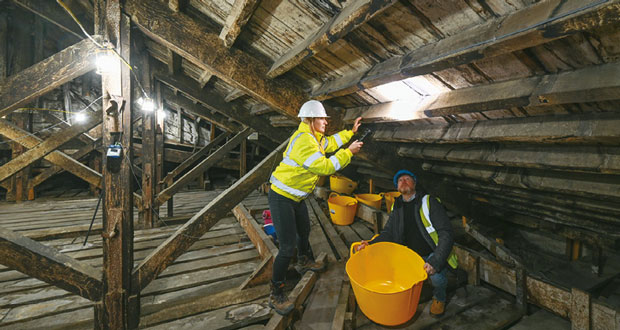The most sustainable building is the one that already exists says Adrian Attwood ACR, Chairman, DBR, an expert on heritage conservation in live public spaces
When Notre-Dame’s spire collapsed into flames in April 2019, I watched the news coverage with the same horror as millions worldwide. But unlike most viewers, I was witnessing not just a tragedy but also a monumental restoration challenge. For over three decades at DBR, we’ve been guardians of Britain’s architectural treasures, and the fire was a stark reminder of what’s at stake.
From our modest beginnings as a masonry contractor in 1990, we apply an agile approach to innovation and planning, with what I call ‘invisible restoration’. In essence, it’s the high-wire act of preserving heritage while daily life goes on largely uninterrupted. It’s conservation without the dreaded ‘Closed for Renovation’ signs.
FIRE SAFETY AT THE PALACE OF WESTMINSTER
The Palace of Westminster isn’t a ‘normal’ government building – it’s the beating heart of British democracy, and it never stops, so when we were tasked with enhancing its fire safety, the logistics behind the multi-million-pound fire safety upgrade were initially daunting.
When the chambers emptied, our craftspeople worked through the night, meticulously enhancing fire resistance in centuries-old doors while maintaining their historic character. We became parliamentary ‘ghosts’; appearing on shift when the corridors quietened and vanishing before the morning’s first debates. We liaised closely with parliament’s security and ceremonial teams to schedule the safe unobtrusive delivery of this vital work.
The technical challenges were formidable too. How do you make a 200-year-old door meet modern fire regulations without changing its appearance? Our solution involved glass enhancements and invisible modifications that preserved historical aesthetics while providing crucial safety upgrades.
After three and a half years of this nocturnal manoeuvring, we received the highest compliment from parliamentary officials; that our presence had gone largely unnoticed despite the scale of the work. In our business, invisibility isn’t just desirable, it’s the gold standard.
RESTORING BRIGHTON ROYAL SUSSEX COUNTY HOSPITAL CHAPEL
The restoration of Brighton’s Royal Sussex County Hospital chapel remains one of our most nerve-wracking projects to date. The logistics involved were highly challenging and demanded careful and meticulous planning and execution.
First, the chapel had to be moved from its original location in the operational hospital Barry Building to its new site. Then the interiors had to be repaired offsite and skilfully reconstructed into a purpose-designed, three-storey concrete superstructure. Our teams had to navigate all the complexities of a working hospital under stringent COVID restrictions, taking extreme care to be mindful of the potential effects of noise and dust in a clinical environment.
A delicate touch was required during deconstruction, transportation, and re-installation requiring frequent briefings with hospital staff to schedule our most disruptive work around patient needs and hospital operations. We had to be sensitive to medical emergencies, procedures and equipment, with rapid response protocols in place.
The chapel restoration preserved its historic character while ensuring the space could continue serving its vital purpose for patients, families and staff. It showed how heritage conservation can enhance the function of modern operational buildings.
BLENHEIM PALACE
In January this year, works on a substantial section of the roof and façade at Blenheim Palace commenced, an expansive project, requiring delicate work, ongoing for at least two years in a bid to enhance fabric resilience and structural longevity. The client was determined “not” to close off the conservation areas during this extensive restoration work.
The project is ongoing and includes a public viewing platform where the conservation work can be viewed at roof level, simultaneously offering a high-level vista of the estate. Our team of craftspeople, whose skills have remained largely unchanged since the Renaissance, have been facilitating craft workshops and community engagement on the skills being used to carry out the work – making restoration work the landmark’s latest educational attraction.
Blenheim Palace has been able to maintain its visitor experience throughout the restoration process. What may have initially been viewed as a potential disruption has been transformed into an enhancement of the visitor experience; proof that with creative thinking, conservation work can actually add value to operational buildings rather than presenting inconvenience.
THE FUTURE OF INVISIBLE RESTORATION
In 35 years of operation at DBR, I’m struck by how our field has evolved. Today, we use drone surveys and 3D modelling alongside traditional lime mortars and hand-carved stonework. This marriage of ancient craft and cutting-edge technology is the future of our profession.
The climate crisis has made this work more vital than ever. The most sustainable building is the one that already exists, and our conservation work now emphasises energy efficiency alongside historical accuracy. When we restore an antique window, we’re not just preserving heritage, we’re reducing carbon footprints by avoiding new construction.
The true measure of our success isn’t found in awards or recognition, though naturally our Royal Warrant is most welcome. It’s in the seamless continuation of life within the buildings we restore. Our motto is a solemn promise: “Making sure the past has a future.” And we’ll continue to achieve that, one inconspicuous restoration at a time.





